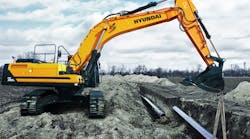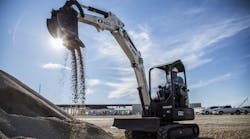Construction Jobs Increase Year over Year in 43 States, AGC Says
Forty-three states and the District of Columbia added construction jobs between June 2017 and June 2018, while 32 states and D.C. added construction jobs between May and June, according to an analysis by the Associated General Contractors of America of Labor Department data released this week. Association officials cautioned that continued job gains may depend on improving the training and education pipeline for workers to enter the industry.
"Construction is proving to be a reliable source of employment growth in nearly every state, and contractors are eager to hire even more workers," said chief economist Ken Simonson. "But finding qualified workers remains a significant challenge as other industries compete for talent, more workers reach retirement age, and fewer young adults chose to pursue careers in construction."
Texas added the most construction jobs during the past year (42,900 jobs, 6.0 percent). Other states adding a large number of new construction jobs for the past 12 months include California (39,800 jobs, 4.9 percent), Florida (29,300 jobs, 5.8 percent), Georgia (16,100 jobs, 8.8 percent), Arizona (14,800 jobs, 10.2 percent) and Michigan (13,200 jobs, 8.1 percent). Arizona, Georgia and Michigan added the highest percentages of new construction jobs during the past year, followed by Nevada (7.6 percent, 6,400 jobs) and Oregon (7.5 percent, 7,300 jobs). Construction employment reached a record high in Louisiana, Massachusetts, New York and Texas.
Only six states shed construction jobs between June 2017 and 2018, while construction employment was unchanged in Hawaii. New Jersey lost the most jobs (-4,800 jobs, -3.1 percent), followed by South Carolina (-4,000 jobs, -3.9 percent) and Missouri (-1,900 jobs, -1.5 percent). The largest percentage loss occurred in South Carolina, followed by New Jersey, Missouri, Kentucky (-0.5 percent, -400 jobs), Oklahoma (-0.4 percent, -300 jobs) and North Dakota (-100 jobs, -0.4 percent).
New York had the largest one-month job gain (3,700 jobs, 0.9 percent) among the 32 states and D.C. that added construction jobs between May and June, followed by Arizona (3,100 jobs, 2.0 percent), Texas (2,900 jobs, 0.4 percent) and Massachusetts (2,300 jobs, 1.4 percent). North Dakota added the highest percentage of construction jobs for the month (3.7 percent, 900 jobs), followed by Arizona, Arkansas (2.0 percent, 1,000 jobs), Connecticut (2.0 percent, 1,200 jobs) and Wyoming (2.0 percent, 400 jobs).
Thirteen states lost construction jobs from May to June, while construction employment was unchanged in five states: Delaware, Florida, Hawaii, New Hampshire and South Dakota. California lost the most construction jobs in June (-2,900, -0.3 percent), followed by Ohio (-2,600 jobs, -1.2 percent), Washington (-2,200 jobs, -1.1 percent), Pennsylvania (1,900 jobs, -0.7 percent) and South Carolina (-1,600 jobs, -1.6 percent). West Virginia lost the highest percentage of construction jobs for the month (-2.1 percent, -700 jobs), followed by South Carolina and Ohio.
Association officials said the job gains mask the difficulty contractors face in finding workers with appropriate skills. They noted the Trump administration had highlighted the importance of training and apprenticeship programs at a White House event on Thursday. They urged federal agencies and Congress to enact a new Perkins Act that increases funding and makes it easier for education officials to craft construction-focused education programs.
"Contractors are eager to help prepare more workers for rewarding construction careers," said Stephen E. Sandherr, the association's chief executive officer. "The more students and young adults can learn about careers in construction, the more they will choose to pursue high-paying careers in the field."










